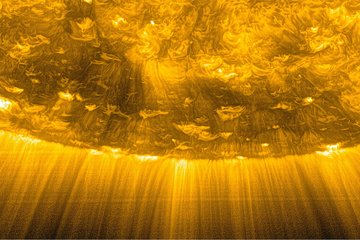All genres
1.
Journal Article
Meter-scale thermal contraction crack polygons on the nucleus of comet 67P/Churyumov-Gerasimenko. Icarus 301, pp. 173 - 188 (2018)
2.
Journal Article
Evidence of sub-surface energy storage in comet 67P from the outburst of 2016 July 03. Mon. Not. Roy. Astron. Soc. 469, pp. S606 - S625 (2017)
3.
Journal Article
Modelling of the outburst on 2015 July 29 observed with OSIRIS cameras in the Southern hemisphere of comet 67P/ChuryumovGerasimenko. Mon. Not. Roy. Astron. Soc. 469, 178G (2017)
4.
Journal Article
Thermophysics of fractures on comet 67P/Churyumov-Gerasimenko. Astronomy and Astrophysics 608, A121 (2017)
5.
Journal Article
Seasonal erosion and restoration of the dust cover on comet 67P/Churyumov-Gerasimenko as observed by OSIRIS onboard Rosetta. Astronomy and Astrophysics 604, A114 (2017)
6.
Journal Article
The pristine interior of comet 67P revealed by the combined Aswan outburst and cliff collapse. Nature Astronomy 1, 0092 (2017)
7.
Journal Article
The pebbles/boulders size distributions on Sais: Rosetta's final landing site on comet 67P/Churyumov-Gerasimenko. Mon. Not. Roy. Astron. Soc. 469 (Suppl_2), pp. 636 - 645 (2017)
8.
Journal Article
Acceleration of individual, decimetre-sized aggregates in the lower coma of comet 67P/Churyumov-Gerasimenko. Mon. Not. Roy. Astron. Soc. 462, pp. S78 - S88 (2016)
9.
Journal Article
The primordial nucleus of comet 67P/Churyumov-Gerasimenko. Astronomy and Astrophysics 592, A63 (2016)
10.
Journal Article
Sublimation of icy aggregates in the coma of comet 67P/Churyumov-Gerasimenko detected with the OSIRIS cameras on board Rosetta. Mon. Not. Roy. Astron. Soc. 462, pp. S57 - S66 (2016)
11.
Journal Article
Sublimation of icy aggregates in the coma of comet 67P/Churyumov-Gerasimenko detected with the OSIRIS cameras on board Rosetta. Mon. Not. Roy. Astron. Soc. 462, pp. S57 - S66 (2016)
12.
Journal Article
The southern hemisphere of 67P/Churyumov-Gerasimenko: Analysis of the preperihelion size-frequency distribution of boulders >= 7m. Astronomy and Astrophysics 592, L2 (2016)
13.
Journal Article
Sunset jets observed on comet 67P/Churyumov-Gerasimenko sustained by subsurface thermal lag. Astronomy and Astrophysics 586, A7 (2016)
14.
Journal Article
Summer fireworks on comet 67P. Mon. Not. Roy. Astron. Soc. 462, pp. S184 - S194 (2016)
15.
Journal Article
Are fractured cliffs the source of cometary dust jets ? Insights from OSIRIS/Rosetta at 67P. Astronomy and Astrophysics 587, A14 (2016)
16.
Journal Article
Fractures on comet 67P/Churyumov-Gerasimenko observed by Rosetta/OSIRIS. Geophysical Research Letters 42 (13), pp. 5170 - 5178 (2015)
17.
Journal Article
On the Evolution of Comets. Space Science Reviews 197, pp. 271 - 296 (2015)
18.
Journal Article
Large heterogeneities in comet 67P as revealed by active pits from sinkhole collapse. Nature 523 (7558), pp. 63 - 66 (2015)
19.
Journal Article
Craters on comets. Planetary and Space Science 107, pp. 53 - 63 (2015)
20.
Talk
Material strength of cliffs and boulders on 67P/Churyumov-Gerasimenko. European Planetary Science Congress, Nantes, France (2015)











